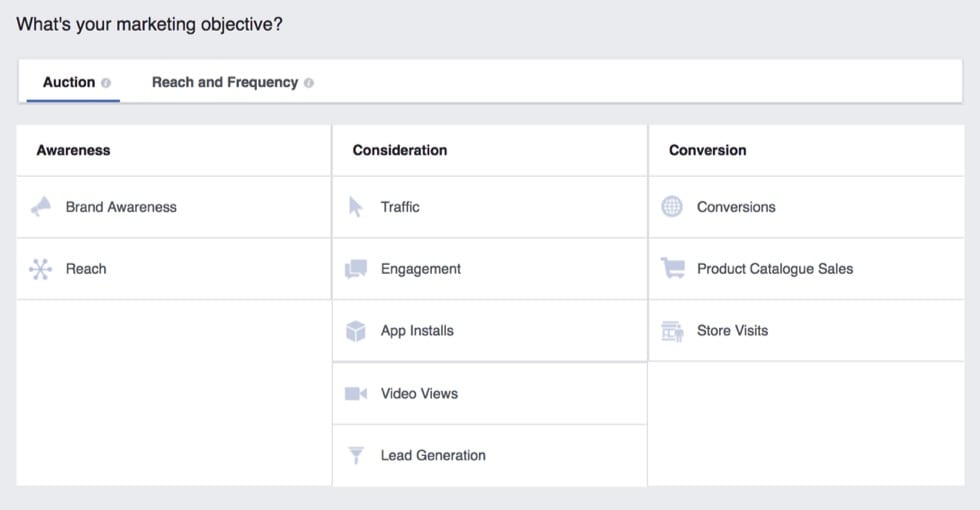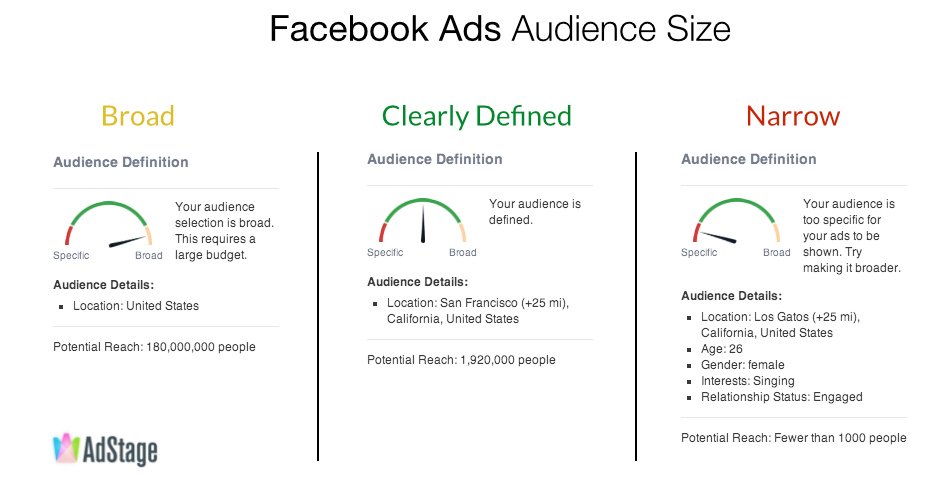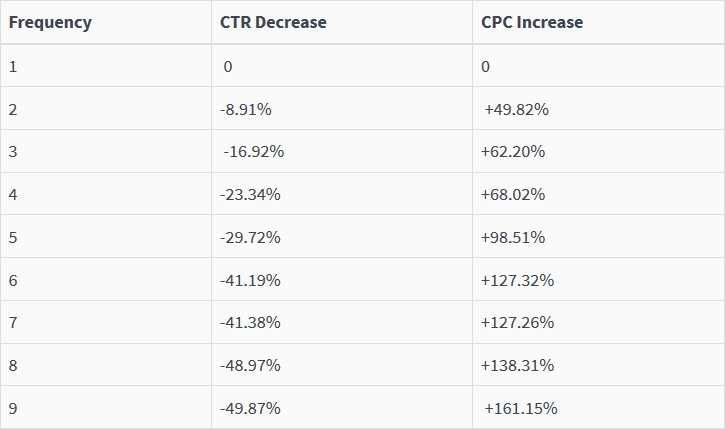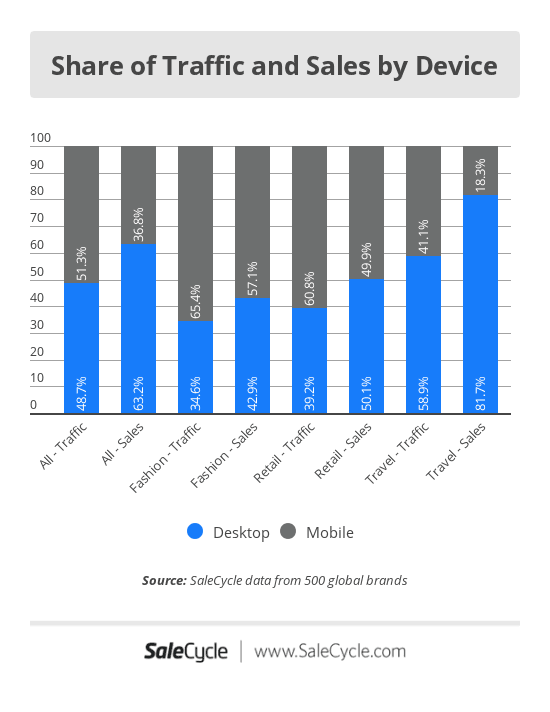
The #1 social media platform globally comes with the most complete social media ads manager.
The Facebook Ads platform grants you with a remarkable set of tools. Getting the hang of the platform and acquiring the essential know-how, usually comes with a little bit of trouble and a shitload of mistakes.
Thankfully, you can learn from the mistakes of others, so you don’t repeat them yourself.
Get the most out of your or your clients’ dollars starting now.
Not Setting a Specific Goal
An ad campaign is not an end in itself. An ad campaign is a mechanism that will let you achieve your goal through exposure. The million dollar question is What is your goal?
You shouldn’t go any further with your campaign if you haven’t answered that first.
Facebook’s got your back and covers your advertising needs for every part of your funnel. From awareness to conversion, your marketing objective should be at the beginning of your thought process and execution.
The question is what do you want to achieve?
You can either try to reach the maximum possible number of people in your audience, get the most Likes for your page, increase the number of your app downloads, and so on. Your goal has to be specific and predetermined.
So can Facebook help you with that? Facebook gives you a lot of options to choose from, through 3 different categories. Each category represents a different stage on your marketing funnel.
Awareness
- Brand Awareness
- Local Awareness
- Reach
Consideration
- Traffic
- Engagement
Post Engagement
Page Likes,
Event Responses
Offer Claims - App Installs
- Video Views
- Lead Generation
Conversion
- Conversions
- Product Catalogue Sales
- Store Visits
Using The Wrong Ad Format
When it comes to advertising, Facebook is the social media platform with the most choices. You have a plethora of formats to choose from so you should experiment first and draw conclusions later.
Do you want to showcase up to ten images within a single ad? Try Carousel.
Would you like to get people shopping from you? Then offer them a deal via the Offers format.
Is info collection what you seek? Then a lead generation campaign is what you should be looking for.

Different formats serve different purposes. A campaign based on a copy and a single image is fine. But will it suffice every single time? Open more doors for creativity. Experiment with them whenever you can and learn what’s suitable for each possible case.
You can find all of Facebook’s ads formats here.
You can’t make the best decision for each campaign if you don’t know your options first.
Setting Too Narrow or Too Broad of an Audience
A too narrow or too broad audience can cost you. Try to find the golden spot.
If your target audience is too broad, you can expect a waste of most of your budget on unqualified prospects. Trying to find your next customers in a target audience that’s too broad is like looking for a needle in the hay, except when you do find the needle you’ve paid for all that hay, too.
Targeting anyone with a pulse is not a good idea; targeting ‘Londoners who like fishing and guns’ and is not a bright idea either. If your target audience is too narrow, you don’t give Facebook’s algorithm adequate volume to make the necessary optimisations. You should also expect a much higher CPM (CPM = Cost Per Mile = The cost for every 1,000 impressions).

Use Facebook’s Relevance Score. Relevance score can help you reach the audience that is more relevant to your ad, thus lowering your cost. Facebook’s Relevance Score is not an end in itself though: your ultimate KPI remains the same, and it shouldn’t come in second.
If your target audience is too narrow, try adding more ‘Interests’ into your targeting so that you can get your audience number higher. If it’s too loose, you can use the ‘Exclusions’ filter to reduce that number.
High Ad Frequency
You check your news feed daily, days go by, but for a particular ad, it’s groundhog day. For some reason, the same Facebook ad appears over and over again. Don’t let this happen to your ads – it’s only a waste of resources.
To know the Frequency of each of your ads, you first have to add it as an option. You can find it at your Ads Manager columns from the ‘Column Customization’ options.
Ad Frequency is the average number of times your ad was shown to each person of your audience. To find that, you have to divide the number your ad was served to each user (impression) with the number total unique users your ad reached (reach).
Frequency = Impression/Reach
The number you get is an average, but it should suffice, since the larger the audience is, the lower the variations become. In the end, they become irrelevant.
An ad fatigue happens when the frequency is high. So how is a frequency calculated and what does ‘high’ mean in this context?
AdEspresso analysed 500 campaigns to show the correlation between frequency and performance (CTR & CPC).

So what’s the maximum frequency your ad should have?
Truth is there is no fixed answer for that; it depends on your industry. AdEspresso advices that under no circumstances should your frequency be above 10.
Your budget should be in line with your campaign’s audience size. A $1,000 campaign needs a bigger audience than a $100 campaign.
Every time the frequency of your campaign is going above 5 and the performance becomes too low, you have two options:
- Redesign your ads. Change the visual as well as the copy to counter banner blindness. Presenting your ad from a different angle allows the user to see it from a fresh angle as well.
- Stop the campaign. Pause the campaign for the current audience and target a totally different one. After a few weeks try targeting the former audience again. The results should look different, for the better.
You should also not forget to exclude converted users: A user saw your ad in their newsfeed, they thought about it, and in the end, they became customers. Congratulations! Now, why would you want to show him the same campaign again? That’s right, you don’t. You can, and you should change that, through Custom Audiences. This is where you will exclude existing customers from unless of course, you are looking to make an upsell.
Going All-In on Day 1
Since you made it thus far, here’s some strategy guidance from one of the veterans of GrowthRocks, Sotiris.
Sotiris, AdWords & Analytics Expert
“Say you just finished your audience research and you found what your ideal audiences are. Your budget is $1,500. What would you do next?What I usually do is spend $10 to $15 for every one of the Facebook interests I’ve selected. After 3 or 4 days I collect all the data and analyse them. I keep the most high-performance audiences and discard the rest.
I then gather all these high-performing interests and create an ad set. Now I’m going to spend more money, around $20 to $30 to this ad set for another 3 or 4 days. Then I’m going to gather some data and analyse them again. What usually follows is a 20-30% daily spending increase on what performs the best and a decrease on what doesn’t.“
Unoptimised Landing Page
Great! You managed to give a user a good enough reason to click on your ad. But this was only the beginning. An ad that leads to a bad landing page is a waste of money.
If a Facebook ad is a portal, then you should be aware of what’s going on on the other side of the portal. Optimise your Landing Page.
Landing page optimisation should be an entire article on its own, but here are a few things to keep in mind when the time comes to make some changes on your page:
- Ensure the least loading time
- Present a clear value proposition
- Post relevant and persuasive content
- Deliver a consistent message
- Balance your content and images
- Create a user-friendly layout
- Use emotional triggers
- Remove, distractions
- Don’t ask for too much information
- Use testimonials
- Provide a Call to Action
Treating Mobile and Desktop the Same
The year 2014 was the turning point for desktop and mobile audiences. It was when the total number of mobile users exceeded desktop users. So naturally, you would want most of your campaigns to be more effective on mobile. But this is where things get tricky. Despite the ongoing rise of mobile devices, users overall prefer buying from their PC’s and laptops than their mobile phones.
This research from SaleCycle shows that sales on desktops are higher, in spite of traffic being more in mobiles.

It looks like people prefer to browse on mobile, but most of them purchase through a desktop. But why is that? For one, it’s more challenging to make a decision when you are on the go. You are more likely to buy a new kitchen appliance from the comfort of your home than from inside a bus where things are usually… tight. Also, a bigger screen allows for easier navigation and the ability to view images in more detail. Some reasons though are unreasonable, such as the feeling of better security on PCs and laptops than in mobiles. Which is precisely that – a feeling. In reality, mobile phones are usually safer than desktops.
Solution: Use the strong points of each platform to your advantage.
For example, you can warm-up your audience with a campaign for awareness purposes which will go live on mobile. Then you can follow-up with a retarget of those users: Create a campaign that’s all about call-to-action, clicks and conversion which users will see through the monitors of their desktops. This is when you will give them coupons, discount codes and incentives.
Having Low-quality Visuals & Copy
So your Facebook Ad is a disaster. You’ve tried everything but maybe you’ve missed this: The very essence of your post. Copywriting and design are what makes an ad what it is, and it is possible that they can’t deliver what they should.
Copy matters. For once, you ought to know how to craft a compelling copy. If you want Facebook not to truncate the text, it should be below or equal to 90 characters (including spaces). No matter the size, the most important or best part of your copy should be at the beginning.
Apart from that, you should also be familiar with the technical side of Facebook’s copywriting rules.
Keep the text on the visual at a minimum: More than 20% can harm your reach.
This is what low text looks like:

And this is what medium and high texts look like:


You want your Facebook ads to look like those in the first row.
It should be noted that visuals such as book covers, album covers, product images, event posters count as exceptions so don’t be too stressed about that label on the biscuits you want to advertise.
If you want to know if the text in your your image will receive the blessings from Facebook’s algorithms, Image Text Check is your best friend.
As for the visual, Facebook’s recommendations are as follows:
File type: jpg or png
Image ratio: 9:16 to 16:9
Resolution: at least 1,200 x 628px
Minimum Image Width in Pixels : 600
Minimum Image Height in Pixels : 600
Aspect Ratio Tolerance : 3%
Conclusion
To sum up, the Facebook ads you should stop making are:
- Not Setting a Specific Goal
- Using The Wrong Ad Format
- Setting Too Narrow or Too Broad of an Audience
- High Ad Frequency
- Going All-In on Day 1
- Unoptimised Landing Page
- Treating Mobile and Desktop the Same
- Having Low-quality Visuals & Copy
The post Stop Making These 8 Rookie Facebook Ads Mistakes appeared first on GrowthRocks.
 Sotiris, AdWords & Analytics Expert
Sotiris, AdWords & Analytics Expert